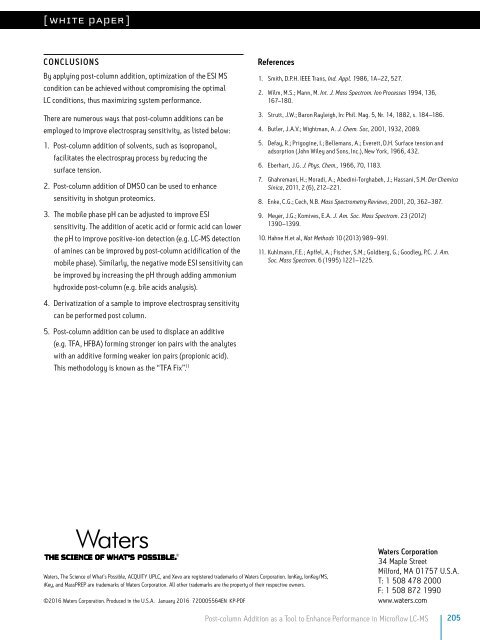ionkey/MS
1TDCbKs
1TDCbKs
You also want an ePaper? Increase the reach of your titles
YUMPU automatically turns print PDFs into web optimized ePapers that Google loves.
CONCLUSIONS<br />
By applying post-column addition, optimization of the ESI <strong>MS</strong><br />
condition can be achieved without compromising the optimal<br />
LC conditions, thus maximizing system performance.<br />
There are numerous ways that post-column additions can be<br />
employed to improve electrospray sensitivity, as listed below:<br />
1. Post-column addition of solvents, such as isopropanol,<br />
facilitates the electrospray process by reducing the<br />
surface tension.<br />
2. Post-column addition of D<strong>MS</strong>O can be used to enhance<br />
sensitivity in shotgun proteomics.<br />
3. The mobile phase pH can be adjusted to improve ESI<br />
sensitivity. The addition of acetic acid or formic acid can lower<br />
the pH to improve positive-ion detection (e.g. LC-<strong>MS</strong> detection<br />
of amines can be improved by post-column acidification of the<br />
mobile phase). Similarly, the negative mode ESI sensitivity can<br />
be improved by increasing the pH through adding ammonium<br />
hydroxide post-column (e.g. bile acids analysis).<br />
References<br />
1. Smith, D.P.H. IEEE Trans, Ind. Appl. 1986, 1A–22, 527.<br />
2. Wilm, M.S.; Mann, M. Int. J. Mass Spectrom. Ion Processes 1994, 136,<br />
167–180.<br />
3. Strutt, J.W.; Baron Rayleigh, In: Phil. Mag. 5, Nr. 14, 1882, s. 184–186.<br />
4. Butler, J.A.V.; Wightman, A. J. Chem. Soc, 2001, 1932, 2089.<br />
5. Defay, R.; Prigogine, I.; Bellemans, A.; Everett, D.H. Surface tension and<br />
adsorption (John Wiley and Sons, Inc.), New York, 1966, 432.<br />
6. Eberhart, J.G. J. Phys. Chem., 1966, 70, 1183.<br />
7. Ghahremani, H.; Moradi, A.; Abedini-Torghabeh, J.; Hassani, S.M. Der Chemica<br />
Sinica, 2011, 2 (6), 212–221.<br />
8. Enke, C.G.; Cech, N.B. Mass Spectrometry Reviews, 2001, 20, 362–387.<br />
9. Meyer, J.G.; Komives, E.A. J. Am. Soc. Mass Spectrom. 23 (2012)<br />
1390–1399.<br />
10. Hahne H.et al, Nat Methods 10 (2013) 989–991.<br />
11. Kuhlmann, F.E.; Apffel, A.; Fischer, S.M.; Goldberg, G.; Goodley, P.C. J. Am.<br />
Soc. Mass Spectrom. 6 (1995) 1221–1225.<br />
4. Derivatization of a sample to improve electrospray sensitivity<br />
can be performed post column.<br />
5. Post-column addition can be used to displace an additive<br />
(e.g. TFA, HFBA) forming stronger ion pairs with the analytes<br />
with an additive forming weaker ion pairs (propionic acid).<br />
This methodology is known as the “TFA Fix”. 11<br />
Waters, The Science of What’s Possible, ACQUITY UPLC, and Xevo are registered trademarks of Waters Corporation. IonKey, IonKey/<strong>MS</strong>,<br />
iKey, and MassPREP are trademarks of Waters Corporation. All other trademarks are the property of their respective owners.<br />
©2016 Waters Corporation. Produced in the U.S.A. January 2016 720005564EN KP-PDF<br />
Waters Corporation<br />
34 Maple Street<br />
Milford, MA 01757 U.S.A.<br />
T: 1 508 478 2000<br />
F: 1 508 872 1990<br />
www.waters.com<br />
Post-column Addition as a Tool to Enhance Performance in Microflow LC-<strong>MS</strong><br />
205


